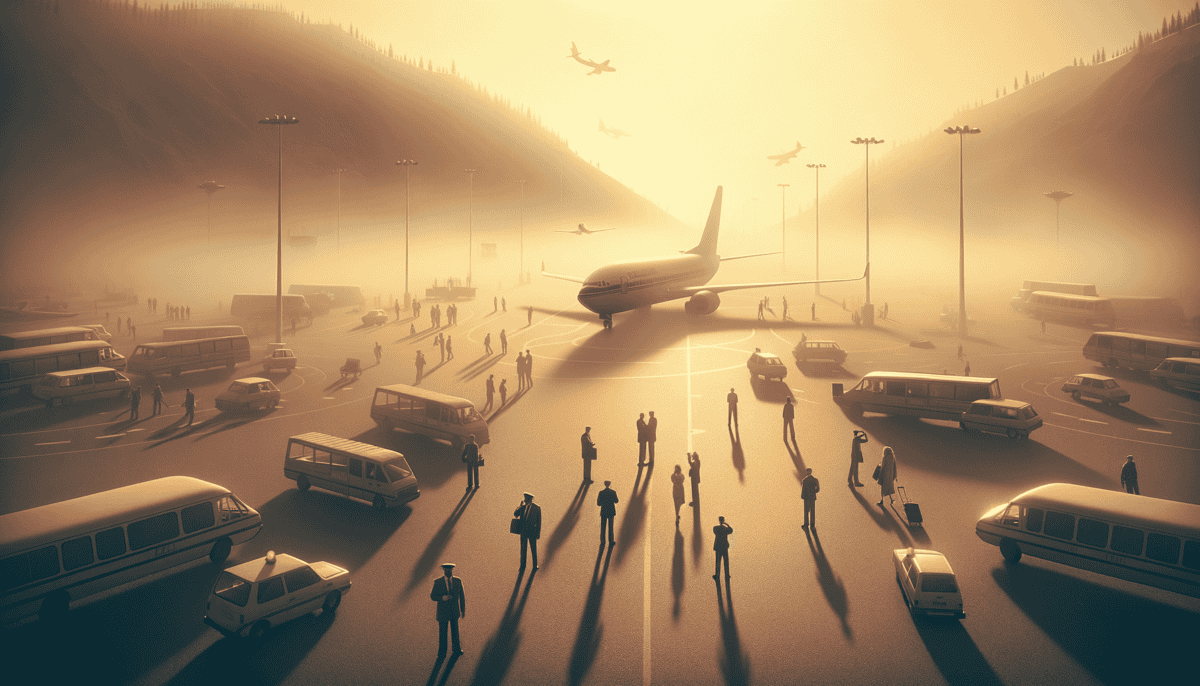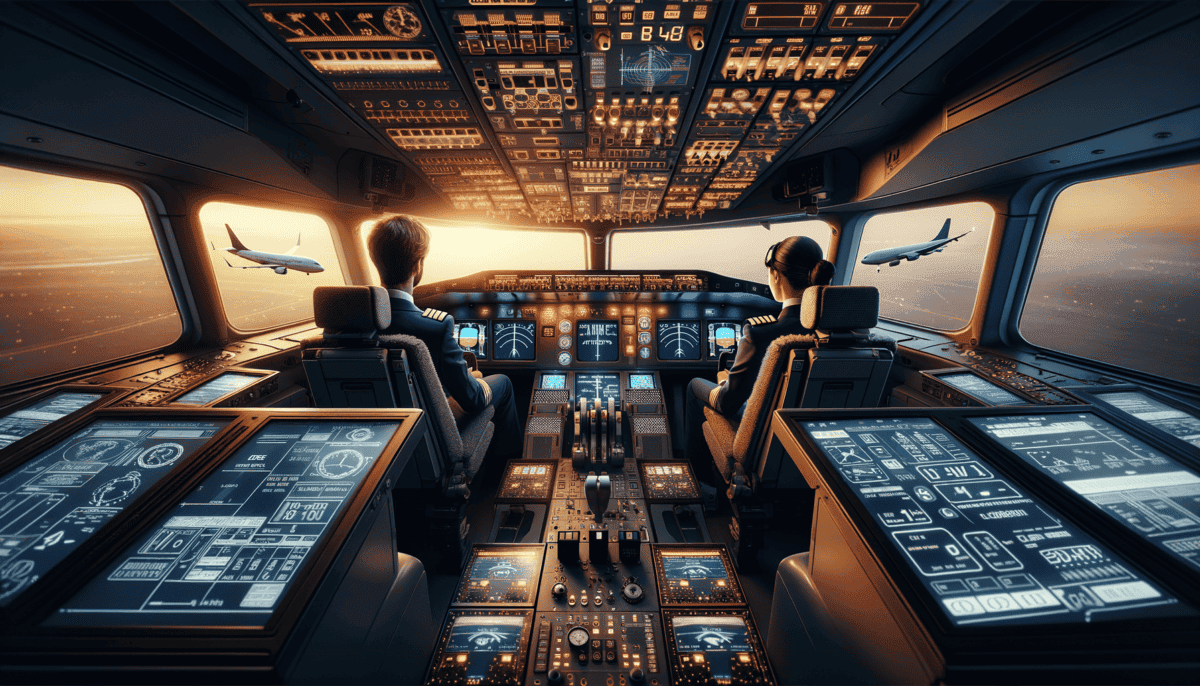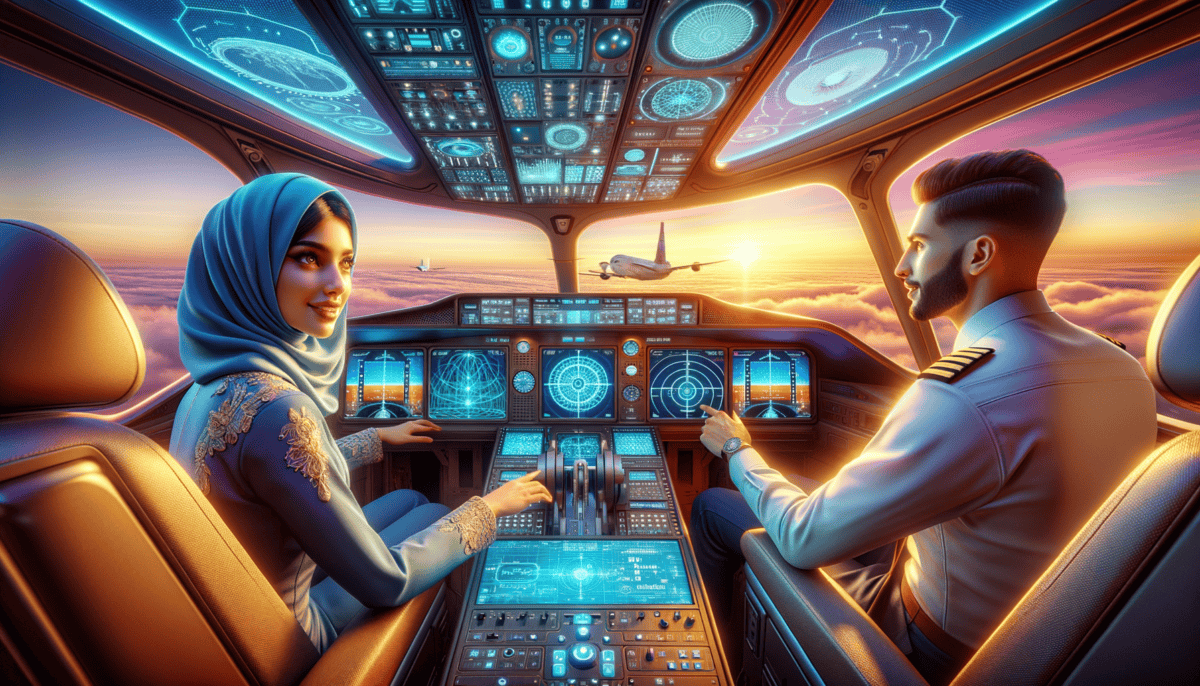The Pioneering Skies
The sun was bright and warm over the Grand Canyon that summer morning in 1956. Two big airplanes filled with happy families soared through the clear blue sky. Neither pilot knew the other plane was nearby. ✈️
"Look at those beautiful red rocks!" little Tommy said to his mom on the TWA plane. He pressed his nose against the window, watching the canyon stretch out below like a giant colorful painting.
At the same time, Captain Jack Morgan in the United Airlines plane checked his instruments. Back then, planes didn't have the special tools we have today to see other aircraft. They flew by looking out the windows and talking to people on the ground.
A Fateful Morning
The two planes moved closer and closer. On the ground, air traffic controllers couldn't see them on radar. In those days, radar only worked near big cities. Over places like the Grand Canyon, pilots were on their own.
“The Grand Canyon was like a magnet for sightseeing flights,” says air safety expert Sarah Chen. “Everyone wanted to see its beauty from above.”
But that beauty led to danger. At 10:30 AM, the unthinkable happened. The two planes crashed into each other high above the canyon.
• No radar over remote areas
• No collision warning systems
• No black boxes to record flight data
• Basic radio communication only
Changes Take Flight
After the crash, people knew things had to change. Little Tommy's dad, who survived because he changed his flight at the last minute, worked hard to make flying safer.
"We need better ways to keep planes apart," he told important people in Washington. "We can't let this happen again."
The crash made everyone think differently about flying. It was like when you learn to look both ways before crossing the street – planes needed new rules too!
Engineers started working on special tools to help pilots see other planes. They created better radar systems that could watch planes everywhere, not just near cities.
A New Era Begins
The skies started to change. Planes got special radios that could talk to more places. Air traffic controllers got better training. It was like putting traffic lights in the sky!
"The Grand Canyon crash was very sad," says pilot Maria Rodriguez. "But it helped make flying much safer for everyone who came after." ⭐
Tommy grew up to become a pilot himself. He never forgot that summer day in 1956. Every time he flies over the Grand Canyon now, he thinks about how different things are.
His favorite part of being a pilot is showing children all the special safety equipment in his cockpit. "Look at all these screens," he tells them. "They help us see every plane in the sky!"
The story of the Grand Canyon crash reminds us that sometimes hard lessons help make the world better. Today's planes are like smart flying computers, keeping everyone safe up in those big blue skies. ️
A Day in Tenerife
The fog was thick as soup at Tenerife Airport. ☁️ Two big planes sat on the runway. One was from KLM, and one was from Pan Am. Nobody knew they were about to learn a very important lesson about talking to each other.
The Foggy Puzzle
Captain Peterson of the Pan Am plane looked out his window. “I can barely see the end of my wing!” he told his crew. The airport was extra busy that day because another airport had closed.
“It was like trying to drive a car with a blindfold on,” says Mike Thompson, who studies plane safety. “The pilots could only use their radios to know where other planes were.”
In the KLM plane, Captain Van Zanten was getting ready to take off. He had been waiting a long time and wanted to get his passengers home.
• The fog made it impossible to see
• Different languages caused confusion
• Radio messages got mixed up
• People used different words for the same things
The Big Mistake
Something went wrong with the radio messages. The KLM crew thought they could take off, but they were wrong. The Pan Am plane was still on the runway!
“Ready for takeoff!” Captain Van Zanten said.
The control tower answered, but their message got mixed up with another one. It was like when two friends try to talk at the same time – nobody can understand anything!
Learning to Listen Better
After that sad day, people who work with planes made big changes. They created special words that everyone must use when talking about flying. It’s like having a special language just for airports!
Today, pilots and airport workers use very clear words:
“Line up and wait” means stay on the runway but don’t take off yet.
“Cleared for takeoff” means it’s safe to go.
Making Flying Safer
Little Sarah loves to watch planes at the airport with her dad. He works as an air traffic controller now. “See how the pilots and tower always repeat messages to each other?” he tells her. “That’s to make sure everyone understands exactly what to do.” ✈️
Airlines also started teaching pilots to work better as teams. If someone thinks something isn’t safe, they must speak up – even if the captain disagrees!
Today’s Sky Talk
Now planes have special computers that show where every other plane is. But good talking is still the most important thing. When pilots and airport workers talk clearly, everyone stays safe.
Jenny, a new pilot, practices these special words every day. “It’s like learning a new language,” she says. “But this language helps keep everyone safe in the sky!”
The lesson from Tenerife taught everyone that clear talking saves lives. Now, every time a pilot or airport worker picks up a radio, they remember to speak clearly and listen carefully.
The Amazing Glide
On a warm summer day in 1983, something incredible happened in Canada. A big plane ran out of fuel high in the sky! But thanks to brave pilots and some lucky math, everyone lived to tell the tale. ✈️
Running on Empty
Captain Bob Pearson was flying Air Canada Flight 143 when the impossible happened. All the warning lights started flashing! Both engines stopped working. The plane was as quiet as a bird gliding through the air.
“It was like riding a bicycle with no pedals,” Captain Pearson would later say. “We had to find a place to land – and fast!”
The Math Mix-Up
Why did the plane run out of fuel? Someone made a mistake when filling up the plane. Canada had just started using different numbers to measure fuel (called metric), but some people were still using the old way.
• The plane needed 22,300 kilograms of fuel
• They only put in 22,300 pounds
• That was less than half of what they needed!
A Lucky Discovery
First Officer Maurice Quintal remembered something amazing – he used to be in the Air Force and knew about a special place called Gimli. It was an old airport that was now used for race cars. ️
“We can make it to Gimli!” Maurice told Captain Pearson. “But we’ll have to glide there – like a paper airplane!”
The Silent Flight
With no engines working, the plane was super quiet. The pilots had to be extra clever. They couldn’t use their normal tools because they needed power to work.
“The plane became a giant glider,” Bob explains. “We had to use the wind to help us fly.”
Landing at Gimli
When they got to Gimli, they saw something scary – people were racing cars on the runway!
The pilots had to think fast. They couldn’t use their normal brakes very well. So they did something clever – they made the plane slide sideways, like when you ski to stop.
The nose wheel broke, but everyone was safe!
Heroes in the Sky
The Gimli Glider, as people called it, taught everyone important lessons about checking numbers carefully. It also showed how brave pilots can save the day when things go wrong.
Little Tommy, who wants to be a pilot, loves this story. “The pilots were like superheroes!” he says. “They turned a big problem into an amazing adventure!”
The plane that landed at Gimli flew for many more years. People would point at it and say, “That’s the plane that glided to safety!” It showed that even when things look really bad, clever thinking and staying calm can save the day.
Safety Takes Flight
After the amazing Gimli Glider story, people wanted to make flying even safer. Smart people worked hard to create new tools to help pilots. Let’s see how they made the friendly skies even friendlier! ️
The Black Box Mystery
Have you ever heard of a black box? It’s not really black – it’s bright orange! This special box is like a diary for airplanes. It remembers everything that happens during a flight.
“The black box is like a superhero’s helper,” says Sarah, an airplane detective. “It tells us the airplane’s story when something goes wrong.” ♀️
• Can survive really hot fires
• Works even underwater
• Records pilot voices
• Keeps track of how the plane moves
Eyes in the Sky
New computers help pilots see better in the dark and through clouds. It’s like giving planes super-vision! ✨
“Now we can see mountains and other planes even when it’s too dark outside,” explains Captain Jamie. “It’s like having cat eyes!”
Weather Watchers
Remember when your mom tells you to take an umbrella? Planes have special weather helpers too! They can spot storm clouds from far away.
The weather radar shows pilots where the scary storms are, so they can fly around them safely. ⛈️
Smart Warnings
Modern planes have warning systems that talk! If a plane gets too close to the ground, a friendly robot voice says “PULL UP!” It’s like having a safety buddy in the cockpit.
Little Maria giggles, “It’s like when my mom tells me to be careful on the playground!”
Learning from Stories
Every time something happens to a plane, people learn from it. They write it down and share it with other pilots. It’s like passing notes in class, but for keeping everyone safe!
“Each story helps us make flying safer,” says Air Safety Teacher Mr. Thompson. “It’s like putting together a giant puzzle of safety.”
Team Safety
Pilots now work better as teams. They talk more and help each other spot problems. It’s like having a buddy system at the swimming pool!
Sally, a new pilot, shares, “We check everything together. Two sets of eyes are better than one!”
The sky is a big place, but these new tools and rules make it friendlier every day. Just like superheroes getting new powers, planes keep getting new ways to stay safe. And the best part? Everyone works together to make sure your flight is as safe as can be!
Making Flying Safer Around the World
Flying has become much safer thanks to people working together from all over the world! Let’s see how different countries team up to keep everyone safe in the sky. ✈️
Working Together
Countries used to have different rules for flying. Now they work as a team! It’s like when kids from different classes join together at recess to play one big game.
“When we work together, we make flying safer for everyone,” says Maria, who helps make flying rules. “It’s like one big family!”
Learning from Each Other
When something goes wrong with a plane in one country, they tell all the other countries right away. It’s like sharing an important secret with your best friends!
• Share safety tips
• Train pilots together
• Check planes carefully
• Make rules that work everywhere
Special Training for Everyone
Pilots and helpers now learn the same things no matter where they’re from. They practice in special pretend planes called simulators.
“It’s like a giant video game that teaches us how to be safe,” laughs Captain Rodriguez. “But this game helps save lives!”
Listening to Stories
People who survived plane problems share their stories. Their brave words help make flying safer for everyone else.
Sarah, who was on a scary flight, tells us: “I shared my story so others could learn from it. Now I feel like a hero!” ⭐
New Safety Rules
Every time we learn something new about safety, we make better rules. It’s like adding new safety pads to a playground!
Little Tommy asks, “So planes get safer every day?” His dad nods, “Yes, just like you get better at riding your bike!”
Helping Each Other
When a country needs help making flying safer, other countries jump in to help. It’s like when bigger kids help smaller kids reach the monkey bars.
“We’re all friends in the sky,” says Flight Teacher Ms. Lee. “When one of us gets better, we all get better!”
Special Safety Tools
New tools help keep track of every plane in the sky. It’s like having a magical map that shows where all the planes are!
Air Traffic Controller Bob smiles, “We can see every plane, just like parents watching kids at the park.” ️
Every day, people from all around the world work hard to make flying safer and better. They share ideas, help each other, and make sure everyone follows the same safety rules. It’s like having a huge team of superheroes watching over every flight! ♂️ ♀️
Flying into Tomorrow
Get ready to peek into the amazing future of flying! Today’s planes are already super safe, but tomorrow’s planes will be even better!
Smart Planes
New planes are getting special computer brains! These smart helpers can spot problems before they happen.
“It’s like having a super-smart friend watching over you during your whole flight,” says Robot Engineer Jenny. “The plane knows what to do to keep everyone safe!”
Weather Wizards
Special tools can now see bad weather from very far away. Planes can avoid storms just like you avoid puddles on a rainy day!
• Special cameras that see through clouds
• Computers that talk to each other
• Auto-pilots that never get tired
• Safety nets in the sky
Green and Clean
Future planes will be better friends to our Earth. They’ll use special fuel that doesn’t make the sky dirty.
“These new planes are like gentle giants,” explains Dr. Green. “They fly quietly and keep our air clean!”
Virtual Reality Training
Pilots now practice in amazing pretend worlds! It’s like playing a super-real video game that teaches them everything about flying safely.
Young pilot Lucy beams: “I can practice landing in snow, rain, or sunshine without leaving the ground!”
Helper Robots
Tiny robots help check every part of the plane. They can crawl into small spaces that humans can’t reach!
“Our robot friends make sure nothing is broken,” says Mechanic Mike. “They’re like tiny doctors for airplanes!”
Space Age Safety
Some ideas for keeping planes safe come from space rockets! Scientists share their best ideas to make flying better for everyone.
Astronaut Alice shares: “What we learn in space helps make planes on Earth safer!”
The Big Picture
Looking back at our journey through airplane safety, we’ve seen how people work together to keep everyone safe in the sky. From the first scary crashes to today’s super-safe planes, we’ve learned so much!
Little planes became big planes. Simple rules became smart rules. And best of all, people from all over the world became one big team!
“The sky isn’t the limit anymore,” smiles Captain Joy. “We keep making flying safer and more amazing every day!” ⭐
As more people fly to exciting places, planes will keep getting safer and better. Maybe someday, you’ll help make flying even safer! Remember, every time you look up at a plane in the sky, thousands of people are working hard to keep that flight safe and happy. The future of flying is bright, and you’re part of it! ✈️






